Background
information |
Contact
details |
Boulogne
Castle-Museum Boulogne
Cathedral,
Old Town & Walls 19th century cathedral -
symbol of church revival after the Revolution Boulogne cathedral was rebuilt in the 19th century as a
symbol of the revival of the French Catholic Church after
the Revolution, in which the old cathedral and so many other
churches were closed and destroyed. The Legend of Notre
Dame Later embellishments of the story had the boat pulled by
a swan - which became the emblem of the town. Pilgrimages Processions of the
Virgin's statue In the Second World War, when Boulogne was in the
German-occupied half of France, four statues were built on
large open trailers. They were pulled through many towns all
over France, eventually arriving in Boulogne, to encourage
people to pray to "our Lady of the Great Return" - the
return of refugees, of prisoners, of soldiers, and of peace.
Back to
top Today you can walk all round the
ramparts, with good views inside to the Old Town (see
below), the Cathedral,
and looking outwards to the newer town centre, the port and
the sea. On most sides, the walls are lined with trees and
gardens - you don't realise you are so high up! Château There are four gateways by which you can
enter the old town inside, one on each side of the
rectangular fortification - see map, right:
Town Walls and the
Old Town within...


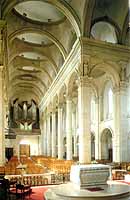
Viewed from the rue de Lille
and its many pavement restaurants, the Italian-style dome of
Boulogne's Cathedral of Notre-Dame dominates the
town. Inside, the nave is a cool quiet oasis in the Old
Town.
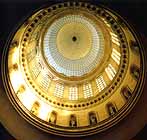
Inside the huge dome, the biggest in Europe after St.
Peters in Rome
In about 633, when St
Omer was a bishop, legend has it that a mysterious boat
carrying a luminous statue of the Virgin Mary appeared in
the estuary of the river Liane at Boulogne - without oars,
sails, or sailors! Townsfolk carried the statue to their
church on the hill, and soon miracles were attributed to
it.
From the 13th to the 16th century, pilgrimages to kneel at
the feet of the "Virgin of the Sea" at Boulogne were very
popular. Medieval pilgrims came especially from England,
France and Flanders. Inns and hospices offered them food and
lodging in Boulogne and along the way; the pilgrims bought
souvenirs, like small lead badges (see below), candles,
etc., which gave work to local craftsmen; whilst donations
and alms made Boulogne's cathedral monastery prosperous.
Back to
top
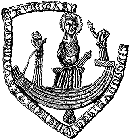
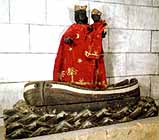
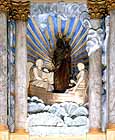
1.
14th century lead pilgrims' badge, showing the "Virgin of
the Sea".
2.
A representation of the Virgin made in 1803, after
Napoleon
allowed the churches to reopen.
3.
1885 statue of Mary, again holding the baby, and the boat in
the waves.
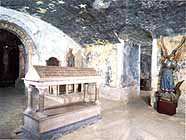
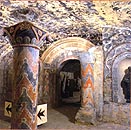
4,5.
Buried crypts of earlier churches were uncovered
during the slow construction of the cathedral, which started
in 1827 after the defeat of Napoleon. Some of these painted
walls and arches date back to the 11th century - a few parts
even to the earliest 7th century church - other to the 15th
century. Amongst the "treasures" in the crypt are a pile of
stone cannon balls from when Henry VIII besieged Boulogne in
1544. Back
to top

"Our Lady of the Great Return" in the Nave
In 1854, when the building of the cathedral was well
advanced and a new railway opened from Paris to Boulogne,
the Abbot started an annual procession in August when the
statue of the Virgin would be carried through the town,
attracting many pilgrims.


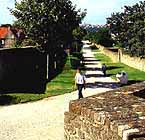
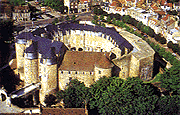
Boulogne: the Porte Neuve by the cathedral. Walking the
walls. The castle in one corner of the walled town - now the
Museum.
In one corner of the walls, there is a medieval castle which
is now the town Museum.
The château strengthens the weakest landward-facing
corner of the town's defensive walls - built in the 13th
century by the Counts of Boulogne, on the foundations of
earlier Roman walls.
D=
Porte des Dunes, P=Porte
des Degrés, G=Porte
Gayole, N=Porte
Neuve. Also marked are:
B=Place Godfrey de Bouillon,
L=rue
de Lille, R=Place
de la Résistance. Back
to top
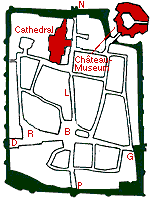
Boulogne's Walls and the Old Town
|
|
Old Roman
Fort Roman
Lighthouses |
|
Spanish
Armada |
|
 Pavement cafes in Godefrey de Bouillon square - part of the lively summer scene in Boulogne's old town. |
Restoration of the Old
Town Today as well as visiting the cathedral, you can enjoy walking round the walls. Inside the walls, many of the old buildings have been restored. Particularly in the rue de Lille and in Godefrey de Bouillon square, there are lively pavement cafes, interesting shops and some good restaurants. Back to top |
|
Cathedrals
to visit: |
|
|
Churches in Nord-PasdeCalais Romans Spanish Armada |
|
|
|
|
|
|